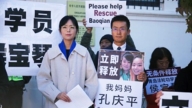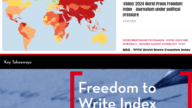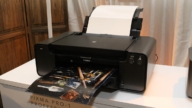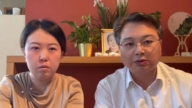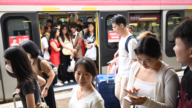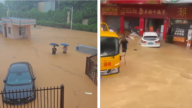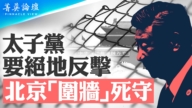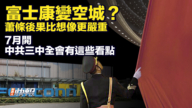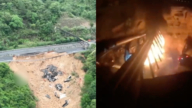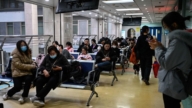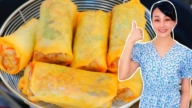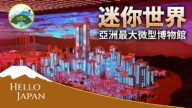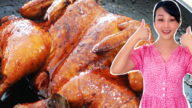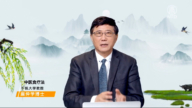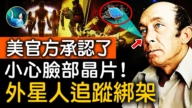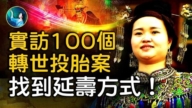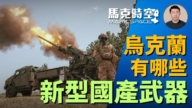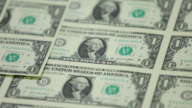【新唐人2011年4月27日訊】《紐約時報》簽約攝影記者杜斌在香港再出版新書“毛主席的煉獄”。這本書收集了關於「大躍進時期」的13萬文字和150多幅珍貴圖畫。杜斌表示,“毛主席的煉獄”再現了那個荒唐而又淒慘的年代。
這本圖文並茂的書籍,收集了毛澤東的黨內講話、糧食官員的私人筆記、地方官員的言行、民間上書黨中央的信件、最新披露的秘密檔案、親歷者的追憶等文字,並以編年史的方式呈現出來。再配以「大躍進時期」的宣傳畫、農民畫、藝術家繪畫、報刊雜誌插圖、攝影照片等為政治服務的作品。從這些歷史的碎片中來回眸那餓死數千萬中國人的黑暗年代。
這些碎片和細節折射出那個時代的荒謬和獨裁者的暴虐。張戎所著的“毛不為人知的故事”中寫道,在一九五八年「大躍進」中,毛澤東為了讓農民老老實實像奴隸一樣幹活,給這些人編上號,而不叫他們的名字。
杜斌:「我覺得像這樣一個很小很小的細節,讓我特別驚訝,也特別震撼,我覺得這就是毛澤東要把人的這種——名字是人的符號嘛——符號給抹殺了,把人變成工具,變成牲口一樣來使用。」
書中記錄的那段歷史充斥著荒唐可笑,甚至在今天看來是黑色幽默。《煉獄》引用《人民畫報》報導的內容,說:湖北省麻城縣創造了畝產3.6萬斤的高產“衛星”。但真相卻是孩子們踩在藏著板凳的水稻上。
其中,劉伯威文章說,公社領導發動群眾搞“人造太陽”和“人造風”來催生禾苗。只見試驗田周圍百來個群眾人人手上捧著個大鏡子,光芒四射直往田裡照。
《煉獄》還引用羅平漢的文章:為了放衛星,試驗田裡不僅施加大量肥料,甚至給莊稼灌狗肉湯,注射葡萄糖。而李凱源文章說,一家手工業社大膽試驗用中藥煉鋼,這些中藥據稱可以起到去氧脫硫、調解炭素的作用。
如果說「大躍進」的上半場是狂熱和搞笑,下半場就是淒厲和哀嚎。當飢餓席捲中華大地,毛澤東灌輸的共產主義理想瞬間坍塌,人們此時才看到大赤龍張開的血盆大口。
杜斌:「篩選這些故事的過程中,我是特別難過的。難過人的生命太卑賤了。在共產黨的眼裡太卑賤了。卑賤的跟一只狗、一只雞、一只螞蟻沒有區別。有些細節透過我篩選出來的文字已經能展示出來,共產黨政權根本就沒有把人民的生命當回事。」
杜斌在《煉獄》中引用劉少奇家鄉人寫給他的一封信,內容說:“劉主席,我們天天在餓肚子,得了浮腫病還不能說,說了就要挨打餓飯,搞不好就說你是“反黨、反三面紅旗”,要送勞改。餓死人只能說是自己病死的。”
而楊繼繩的《墓碑》一書也被杜斌引用了一段話,“當年信陽庫裡有糧10億多斤,當年產量29多億斤,共40億斤。饑民看著糧庫裡有糧,也沒有人想到搶糧食。有的農民坐在旁邊等著政府開倉放糧,他們坐在糧庫旁邊喊:“共產黨,毛主席,救救我們!”有人就餓死在糧庫旁邊。”
人吃人的慘劇遍及每個村莊。《煉獄》引述梁志遠的文章說,“有時路上死人被人埋後,一夜就不見屍體了。有些地方,農民家裏死了人,為了防止被人扒吃,就守墳多夜,待屍體腐爛發臭為止。有的吃人家的死人,有的吃自家的死人﹔人肉有吃熟的,也有吃生的﹔有吃死屍的,也有殺吃活人的。”
杜斌表示,《煉獄》這本書的出版正好趕上中共建黨九十週年。現在北京的書店裡關於中共黨史的書一本接一本的在出版,還有一本書專門寫給中學生看的。中共試圖美化他的歷史,遇到「文革」和「大躍進」的內容就輕描淡寫帶過,竭力把它不光彩的那一面從他的歷史裡面剔除。而《煉獄》這本書可以說是把殘缺的歷史補齊,把真實的傷痛呈現。
新唐人記者秦雪、王明宇採訪報導。
======
“Chairman Mao’s Purgatory” – The Reality
Du Bin, a New York Times’ signed reporter,
published in Hong Kong a new book, called
“Chairman Mao’s Purgatory”. .
This book is about the Great Leap Forward
and has 130,000 characters
and over 150 valuable pictures.
Du Bin said: “’Chairman Mao’s purgatory’ reflects
all those ridiculous and miserable years.”
This book in the form of chronicle, records Mao’s
speech within the party, agricultural officials’
private diaries, the behavior of local authorities,
letters from common people to the Central Party,
newly revealed secret documents, witnesses’
memories. The book recalls the dark age when
tens of millions of Chinese people starved to death,
with historical posters, farmer paintings, photos,
art drawings, newspaper and magazines’ pictures,
serving the politics during the Great Leap Forward.
These fragments and details reflect those ridiculous
years and the dictator’s outrage. According to
Zhang Rong’s book “Mao: The Unknown Story”,
to make peasants work as slaves during 1950s’
Great Leap Forward, Mao Zedong assigned
numbers to them instead of calling their names.
Du Bin said: “I find such a small detail surprising
and shocking. Mao erased people’s names
which were their identities and
utilized them as tools and animals.”
We can find in the book those ridiculous years
and black humor when we look back. “Purgatory”
cites China Pictorial’s reports: “Macheng County
in Hubei Province created a ‘satellite’ of producing
36,000 jin (18,000 kg) of grain per mu.”
But actually children were standing on paddy rice
propped with hidden benches.
According to Liu Bowei’s article, officials of people’s
commune organized activities like “man-made sun”
and “man-made wind” among people to hasten the
growth of rice. Hundreds of people were standing
around experimental fields with mirrors in hands,
making the sunshine reflect into the field.
“Purgatory” cites Luo Pinghan’s article: “To launch
satellites, people applied fertilizers excessively and
watered the rice with dog meat soup and glucose.”
Also according to Li Kai’s article, a handicraft
commune even made steel with Chinese medicine,
which was believed to remove oxygen, sulfur
and to control carbon content.
The first half of the Great Leap Forward was just
craziness and humor, but the second half was
a tragedy. When hunger swept the whole country,
the communist ideal implanted by Mao collapsed
and at that moment people saw the red dragon
opening its bloody mouth.
Du Bin: “I was sad when choosing the stories,
because people were so humble in the eyes
of communist party, as humble as a dog, hen, ant.
Some details I selected can truly reflect the fact
that the communist regime doesn’t care
about people’s lives at all. ”
In “Purgatory”, Du Bin cited a letter to Liu Shaoqi
from his fellow villagers which said: “President Liu,
we are starving everyday and developing edemas.
But we couldn’t talk about it, otherwise we’ll have
no food, be labeled as “anti-party and
against the three red banners” and be sent to
forced labor camp. Once a person starves to death,
people could only say that he dies of disease.”
Du Bin also cited a paragraph from Yang Jisheng’s
book, “Tombstone", “There was over 1 billion jin of
grain in Xinyang City’s warehouse and the total
storage is 4 billion jin, with 2.9 billion jin production
that year. But not even one famine victim
considered to steal food, knowing there’s plenty
in the warehouse. Some peasants waited
outside the warehouse for the government
to distribute food and shouted:
‘Communist party, Chairman Mao, help us!’
Some people died at the warehouse.”
The tragedy of people eating each other swept
every village. “Purgatory” cites Liang Zhiyuan’s
article, “Sometimes a dead person was buried
but the body disappeared overnight. In some areas,
to protect dead bodies from being dug and eaten,
peasants watched their family members’ graves
for several nights until the bodies started
to decompose and putrefy. Some people ate
dead bodies from other families and some ate
dead bodies from their own families; people ate
cooked or raw human flesh; some ate
dead bodies and some killed and ate live people.”
Chinese Communist Party) 90th anniversary.
Other books about CCP’s history are coming out
one by one in Beijing’s bookstores and there is
even one for middle school students.
In these books, CCP tries to glorify its past and
writes lightly about the Cultural Revolution and
the Great Leap Forward, trying to remove
its dark side from history. But “Purgatory” fills
the blank of history and presents the real pains.
NTD reporters Qin Xue and Wang Mingyu


